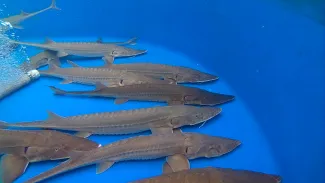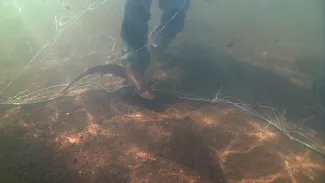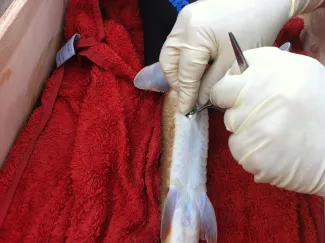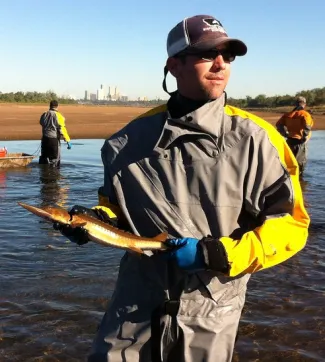It’s uncommon for sensitive fish or wildlife to be found in heavily urbanized areas. But that’s exactly where biologist Josh Johnston, Northeast Region fisheries supervisor for the Oklahoma Department of Wildlife Conservation, found a rare fish armored with razor-sharp scales and a shovel-shaped snout.

With a flattened head, sturgeon are well-adapted for life at the bottom of prairie rivers.
As motorists were crossing the Arkansas River on Tulsa’s busy Interstate 44 bridge, Johnston and two other biologists were nearby in dry suits, catching shovelnose sturgeon by hand.
“It was way too cold to be swimming. The water temperature was only a degree above freezing. But we knew where four or five shovelnose had congregated,” Johnston said.
The cold swim and the handful of fish kicked off a four-year project that aimed to increase knowledge about Oklahoma’s sturgeon population and what those fish need to survive in our state.
With hopes of writing the first chapter of Oklahoma’s shovelnose sturgeon story, Johnston would end up catching and tracking at least 25 of the rare fish.
Shovelnose Sturgeon: A Living “Pool Cleaner”
“When you think of sturgeon, you typically think of a big fish. But shovelnose sturgeon are really petite. A large shovelnose weighs only 2 or 3 pounds,” Johnston said. “The biggest fish we caught was 32 inches in total length; the tail was about 8 inches long and, at the end, was smaller than my pinkie finger.”
Shovelnose sturgeon spend much of their lives in swift-moving water at the bottom of large rivers. “These fish are built with a flattened head and a vacuum cleaner-type mouth,” Johnston said. “They’re a lot like a pool cleaner. They cling to the bottom of the river, filter freshwater mussels, snails and sometimes other fish out of the sand, and then spit the sand back out.”
While the project’s first fish were caught by hand, the technique was only successful when water temperatures hovered just above freezing and the current was slow. To catch fish outside of winter’s deep freeze, Johnston’s team tried eight other techniques used in past sturgeon research.
“None of the methods that worked in other parts of the nation worked well in Oklahoma,” Johnston said. Only five shovelnose sturgeon were caught using traditional gear.
Instead, the team reached out to the U.S. Army Corp of Engineers and Southwestern Power Administration, Tulsa’s primary water management authorities, to slow the discharge rates for the Arkansas River. “After a weekend of no discharge, we were able to find pockets of water that were relatively deep for the river – about 3 feet deep – that held a lot of sturgeon,” Johnston said.

Collection trips for the study were most successful when Johnston and a team of biologists slowly walked upstream in the river visually searching for the fish. When a shovelnose sturgeon was encountered, a net encircled one crew member and the fish. After being guided into the net, the sturgeon was quickly captured.
Once the project’s 25 fish were captured, they were temporarily held in a large tank at the Oklahoma Aquarium in Jenks, just a stone’s throw from the study site, until the next phase of the project.
Sounds of the Sand
“We always knew it would be hard to track our sturgeon in the Arkansas River,” Johnston said. “When you pair the naturally salty conditions of the river with the sturgeon’s tendency to hang out on the bottom, the traditional radio-telemetry equipment used to track animals isn’t an option.”
Enter Gene Parker, a doctor of veterinary medicine with Oklahoma State University. Parker has helped the Wildlife Department with other fish-tracking projects and had the skills needed to implant ultrasonic tracking devices in the sturgeon.
“We didn’t want to take any chances with such a rare fish,” Johnston said. “Even though Dr. Parker was in the field working on wild fish, it was just like he was working on a pet in his surgery room. He even used absorbable stitches because we weren’t likely to recapture the fish.”

To track shovelnose sturgeon movement, Wildlife Department biologists partnered with Gene Parker, a veterinarian with Oklahoma State University, to implant ultrasonic tracking devices in the sturgeon.
A side benefit of having the fish in hand for the tracking project was being able to check the sturgeon’s reproductive status. “A majority of our fish were female,” Johnston said. “All of those females were mature, and most of them were gravid, or had eggs. That’s good news for the river.”
When the fish were returned to the river with the implanted tracking devices, Johnston started monitoring their movements. “They’re pretty much homebodies, staying in one general vicinity for several months. But when temperatures reach 65 to 70 degrees, the urge to migrate kicks in,” Johnston said.
Unfortunately, the Tulsa area started receiving heavy rain just before the migratory trigger. Flows were above normal from mid-May to late August, turning the river into a very noisy environment for the project’s trackers.
“We were using an underwater microphone to track the fish,” Johnston said. In addition to amplifying the beeps from the sturgeon’s tracking devices, the microphone would also amplify the sound of individual sand particles hitting each other. “Recordings of those sand particles sounded more like loud screaming. Even the digital software was unable to pick out the transmitter’s signals from the bouncing sand.”
While the spring spawning and migration events weren’t documented as hoped, Johnston was able to track a few of the sturgeon’s movements and found “hotspots” or centers of activity.
“One fish stayed around the I-44 bridge for several months before moving 16 miles downstream to another hotspot in a mere 17 hours. Another fish almost made it to the Webbers Falls area before turning back into the Verdigris River” about 60 miles downstream.
The Rivers Must Run
For Johnston, this project reinforced the importance of intact prairie rivers for our fish communities. Sturgeon, once found throughout the Mississippi and Missouri river drainages, have suffered significant declines across their range, primarily due to the loss of free-flowing rivers.
“Shovelnose sturgeon are a really strange fish that have been around longer than even paddlefish,” Johnston said. “They’ve survived as a species for 100 million years, even with major changes in temperature and water chemistry. They’re really not that fragile until you cut their system – their habitat – in half.
“Right now, Oklahoma’s Arkansas and Red rivers form the southwestern boundary of their range, and we’re on the knife’s edge of having stretches of prairie river long enough to support these sturgeon.”
Similar to other prairie river fish, shovelnose sturgeon rely on long stretches of free-flowing water that keep their developing young oxygenated and afloat. Once the eggs hatch, the young sturgeon, known as fry, need to float downstream for seven days.
“If the stream segment isn’t long enough because of a dam or other barrier, the fry could hatch, drift downstream and end up in a reservoir. Without fast-moving water, the fry would fall to the bottom of that reservoir and suffocate,” Johnston said. “Even if they were able to make it through a reservoir because of flooding, they could never make it back upstream and repopulate their original stretch of river.”

“We need to make sure we think about how changes to our rivers, especially our limited prairie rivers, will impact our fish and wildlife.”
Even with the challenge of shrinking habitat, Oklahoma remains one of the few places that can support these unique fish. “It’s amazing that we have fish – fish that some people don’t even know exist – right here in Jenks, Oklahoma,” Johnston said. “If you think about it, documentaries like Planet Earth could be made in our state, and fish like shovelnose are so cool, they could make the cut.”
This project was funded by the Wildlife Department through the federally funded State Wildlife Grants Program, Grant F13AF01276.